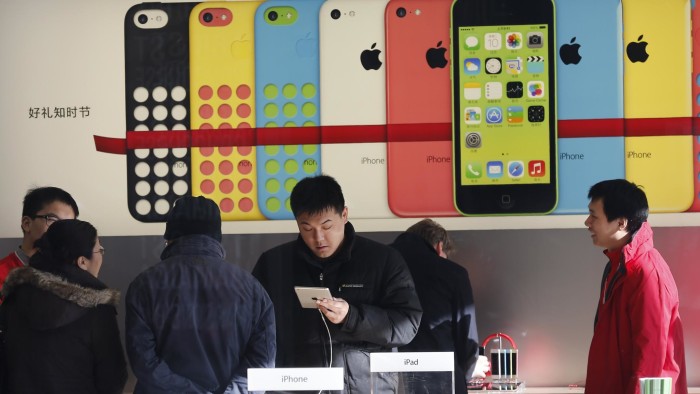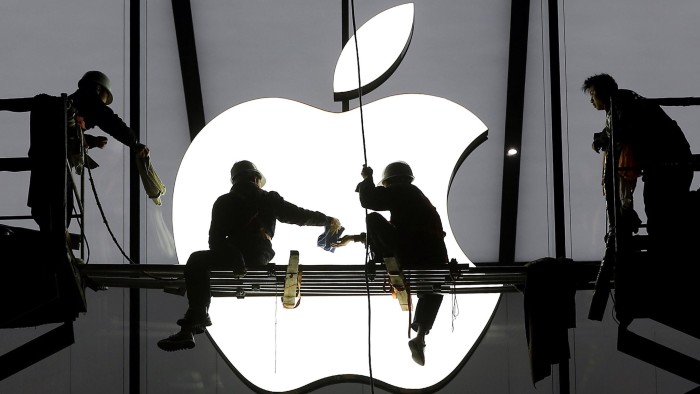How does Apple top a record quarter?

Roula Khalaf, Editor of the FT, selects her favourite stories in this weekly newsletter.
How do you follow the most profitable quarter in corporate history? That is the question now hanging over Apple.
The popularity of larger iPhones and success in China helped Apple to post $18bn in net profit on $75bn worth of sales for the three months that ended in December, beating forecasts on almost every metric.
That marks the fourth quarter in a row that Apple has burst through Wall Street’s estimates, a return to the expectation-beating ways that eluded the iPhone maker through much of 2013.
Investors welcomed the news, sending the company’s share price up 6 per cent by close of trading.
As Apple’s marketing tagline for the iPhone 6 puts it, the quarter was “bigger than big”.
Alongside the strong numbers, Tim Cook, chief executive, put paid to investor concerns about how much room was left for iPhone sales to grow, its manufacturing capabilities after September’s spate of complaints about bent devices, and the company’s ability to fend off competition from the likes of Samsung and China’s Xiaomi.
Now, with Apple’s share price heading back towards its all-time highs, it faces the greater challenge of living up to its own raised expectations.
The stock gained 5.7 per cent to $115.40 in after-hours trading following Tuesday’s results. Its record high was $119.75.
The holiday quarter is always Apple’s most lucrative and, as in previous years, the company has forecast a sequential decline in revenues to $52bn-$55bn for the current period.
That still implies around 55m iPhones will be sold in the quarter, says mobile analyst Jan Dawson, “which would still be their second-highest quarter ever”.
This time last year Apple disappointed the market because it did not make enough of the more popular iPhone 5s model, and supply shortages held back sales.
Mr Cook, who led Apple’s supply-chain operations before becoming chief executive, learned from his mistake: Apple sold almost all of the 74.5m iPhones its suppliers shipped in the period — and still had customers waiting in line for more.
“One of the things that they did this quarter amazingly well, given how stretched they were last year at this time, was meet the vast majority of demand,” says Mr Dawson, founder of Jackdaw Research.
For many tech companies, widening the market for a product comes at a cost to pricing or profit margins. Not so for Apple, whose gross margin increased to its highest since 2012 as manufacturing leverage kicked in. Its iPhones commanded an all-time-high average selling price of $687, up $50 on the same period a year ago and almost double those of its nearest competitors.
Apple’s records in numbers

Apple broke a series of records with its extraordinary results for the three months ended December, notably earning the biggest quarterly net income of any public company in history. Here is a guide to Apple’s performance in numbers.
Continue reading
Analysts attribute much of the iPhone’s continuing popularity to pent-up demand for larger smartphones, which until September had only been available from vendors such as Samsung using Google’s Android operating system.
The iPhone 6 and even larger 6 Plus attracted both Android “switchers” and first-time Apple smartphone buyers in record numbers, Mr Cook said during Tuesday’s earnings call.
Carolina Milanesi, chief of research at Kantar Worldpanel ComTech, a market researcher, said 12.5 per cent of US iPhone customers in the three months to December had switched from Android, up on the previous period.*
Yet there is more to Apple’s momentum than just bigger screens, say Ms Milanesi.
“You still have the iPhone 5c and 5S in the top 10 most sold devices across different markets,” she says. Those devices, now over a year old, are sold at a discount to the latest models, allowing Apple to appeal to other customers without having to release a “cheap” iPhone that might dilute its premium brand. “It’s the strength of the portfolio across the board that helps them,” Ms Milanesi says.
That may be true in established smartphone markets such as the US and Europe. But in China, where iPhone sales doubled in the past quarter, the attention is fixed on the high end.
CK Lu, who analyses China’s smartphone market for research firm Gartner, says Apple has sold so well in China “because it is a premium brand and a premium brand with very little competition in the market”.
Lex on Apple

The key concept when assessing prospects is recurring revenue, rather than growth
Continue reading
“There is a worship of luxury brands in China — if you give a gift to your girlfriend, you give her an iPhone,” he says. Gift-giving around February’s Chinese new year should ensure iPhone sales remain strong in the current quarter ending in March.
The release of the Apple Watch in April is expected to provide more support — if only by giving iPhone owners another reason to stay within the Apple family rather than decamping to Samsung or Xiaomi. The accessory, which will cost upwards of $350, only works if customers already have an iPhone.
Another service encouraging loyalty is Apple Pay. Two out of every three contactless payments in the US are now made using the iPhone, and Mr Cook hinted that the mobile-wallet app could soon be available in more countries.
“There’s not a day that goes by that I don’t get notes from many businesses outside the US wanting Apple Pay, both banks and merchants,” he said. “2015 will be the year of Apple Pay.”
Despite fielding several questions from analysts about how to sustain growth, Mr Cook said he felt “incredibly bullish” about Apple’s prospects: “Between the switchers and the people that are new to smartphones and selected an iPhone, and upgrades . . . we feel very good about what’s in front of us.”
That confidence may backfire if Wall Street’s enthusiasm starts to get ahead of Apple’s capacity to deliver.
“When they start doing well, everyone starts to expect miracles,” warns Mr Dawson.
Nonetheless, experts are finding it hard to predict where Apple might slip up. “The momentum for them is relentless,” says Geoff Blaber, an analyst at CCS Insight. “I struggle to find where they could come undone.”
*This article has been amended from a previous version that referred to European customers
Comments